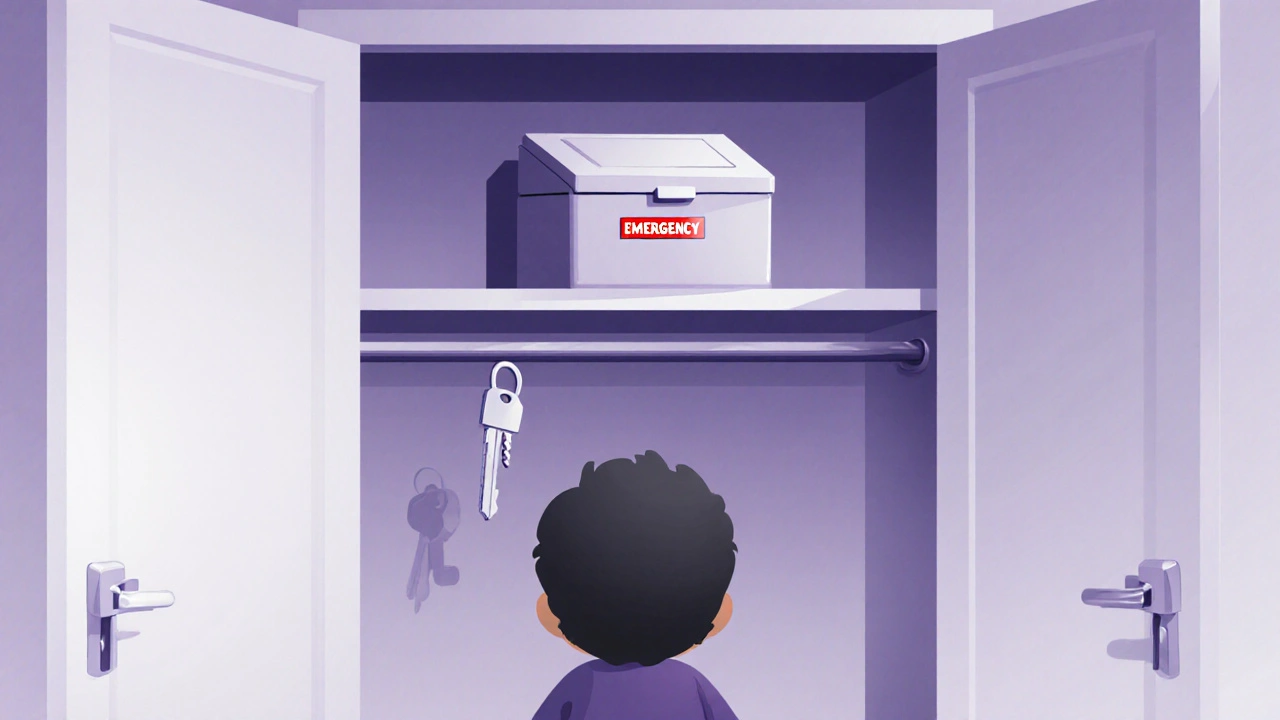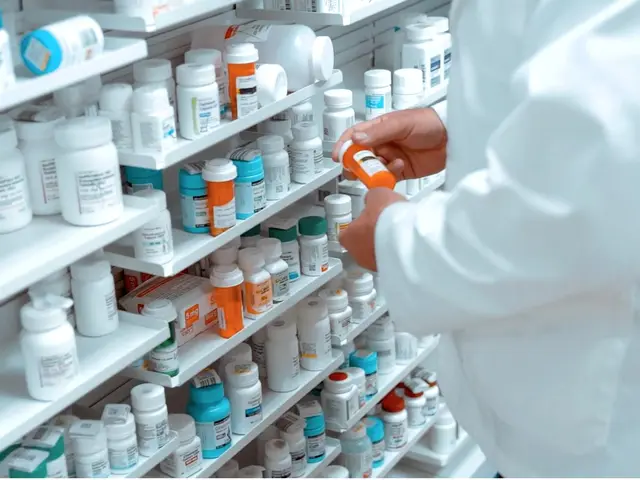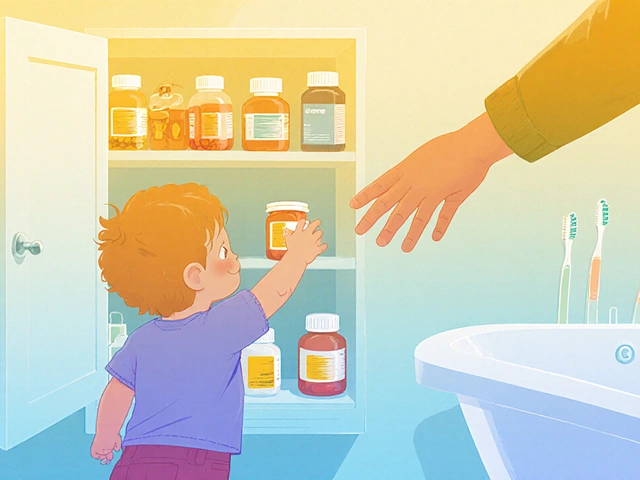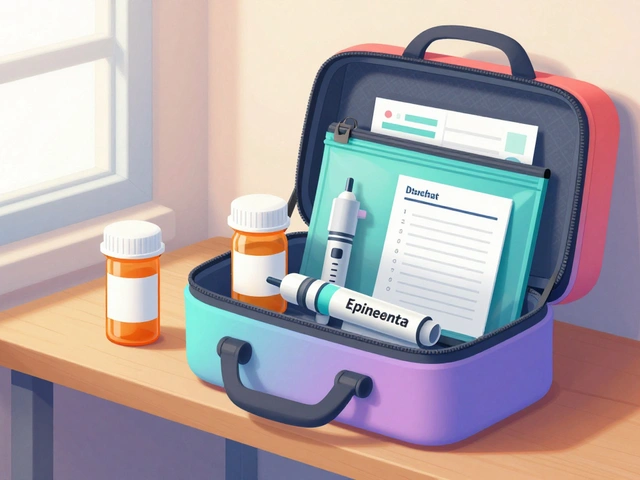Storing Medications Away from Children: Safety Best Practices

Every year, over 60,000 children under five end up in emergency rooms because they got into medications they weren’t supposed to. That’s not a rare accident-it’s a preventable crisis. And it’s not just about pills left on the counter. It’s about the bottle in the bathroom cabinet, the chewable vitamins in the nightstand, the insulin pen in the diaper bag. If you have kids, or even just visit homes with kids, you need to treat every medication like it’s a loaded gun-because to a curious toddler, it looks like candy.
Why "Out of Sight" Isn’t Enough
You’ve heard it before: "Keep meds out of reach." But that’s not enough. Children as young as 18 months can climb on chairs, pull open drawers, and twist off child-resistant caps. A 2022 study from the Journal of Pediatric Health Care found that 62% of toddlers can open a standard cabinet latch within 30 seconds. Even worse? 50% of kids can get into a safety-cap bottle in under a minute-even if it’s labeled "child-resistant." The truth is, child-resistant packaging is a backup, not a solution. It’s designed to slow down a child long enough for an adult to intervene-not to stop them completely. That’s why experts say: out of sight is necessary, but insufficient without physical barriers.The Only Reliable Method: Locked Storage
The most effective way to keep medications away from children? Lock them up. Not just in a high cabinet. Not just in a drawer. Lock it up. A 2022 study tracking 1,200 households showed that locked cabinets prevented access 98% of the time. High shelves alone? Only 72% effective. Plain sight? Even worse. You don’t need a fancy safe. A simple plastic or steel lockbox-about the size of a shoebox-works fine. Look for one with a tamper-evident seal and a key or combination lock. Avoid those cheap plastic boxes with flimsy latches. The ones that cost $45-$120? Worth every penny. Amazon reviews for Med-Tek lock boxes show 4.3 out of 5 stars from over 1,200 users, with 92% reporting zero access by kids.Where NOT to Store Medications
Some spots are dangerous even if they seem logical:- Bathroom cabinets: 41% of parents store meds here because it’s convenient. But kids know where the toothpaste is. And they can reach the sink.
- Purse or diaper bag: A 2022 CDC case study showed a 22-month-old swallowed opioids from an unsecured bag left on a couch. Emergency meds should be accessible to adults-but still locked.
- Kitchen counters: Even if you "only leave it out for a minute," kids can grab it in under 90 seconds. The Up and Away campaign’s "Two-Minute Rule" says: never leave meds unattended for more than 120 seconds.
- Grandparents’ homes: Express Scripts found 76% of grandparents don’t lock up meds when kids visit. Many believe, "My grandchild knows not to touch medicine." That’s a deadly assumption.
Special Cases: Insulin, Inhalers, and Emergency Meds
Some medications can’t be locked away completely. If your child uses an asthma inhaler or an epinephrine auto-injector, you need it accessible during an emergency. The solution? A two-tier system.- Emergency meds: Keep them in a locked box that opens quickly-like a key lock, not a biometric safe. Test it yourself: can you get to it in under 3 seconds? If not, reposition it.
- Refrigerated meds: Insulin must stay between 36°-46°F. Store it in a locked compartment inside the fridge-not on the top shelf where kids can reach it. Some lockboxes are designed to fit inside fridges.
- Narcan: If you have opioid rescue medication, store it high and locked, but make sure every adult in the house knows where it is. NACoA’s 2025 guide says 87% of overdoses are reversed when Narcan is within 30 seconds’ reach.

Travel Is a High-Risk Time
Pediatric poisonings spike by 31% during holidays and travel, according to CDC 2023 data. Why? Routine breaks. Meds go in suitcases. Pills get left in hotel drawers. Backpacks get left on beds. The CDC now offers free "Travel Safety Kits"-small, portable lockboxes that fit in hotel safes or carry-ons. If you’re flying, pack meds in your carry-on, not checked luggage. Use the lockbox. Even if you’re only away for a night. One parent on Reddit shared how their 3-year-old found a bottle of melatonin in a hotel nightstand. They made it to the ER in time. But it was a close call.What About Teens?
It’s not just toddlers. Teens are the second-largest group for accidental and intentional medication misuse. The National Association of Pediatric Nurse Practitioners recommends a "monitored system" for teens: each dose is logged, and an adult verifies it. This cuts prescription misuse by 67% over time. If your teen has ADHD meds, painkillers, or anxiety prescriptions, don’t just trust them to "be careful." Use a lockbox with a logbook or a smart pill dispenser that records when it’s opened. It’s not about distrust-it’s about safety.Disposal Matters Too
Don’t flush meds. Don’t toss them in the trash. The FDA says to mix them with something unappetizing-like coffee grounds or cat litter-then seal them in a plastic bag before throwing them out. Better yet: use a permanent disposal kiosk. 78% of U.S. pharmacies now offer them, free of charge. Check your local pharmacy. Many have drop boxes in the lobby. Some even take expired vitamins and supplements. If you’re unsure, call ahead. Proper disposal prevents kids-and pets-from finding old pills months later.
Make It a Habit, Not a Chore
The most successful families don’t think about storage-they just do it. Like buckling a seatbelt. Like checking smoke alarms. It’s automatic. Start with this:- Buy one lockbox. Put all meds inside-prescription, OTC, vitamins, supplements.
- Place it high, locked, and out of sight. Not the bathroom. Not the kitchen counter. A bedroom closet or kitchen cabinet with a lock.
- Keep emergency meds in a second, fast-access lockbox near the front door or bedroom.
- Teach everyone who visits: "We lock our meds. Please don’t leave yours out."
- Do a quick check every time you use a medication: "Did I lock it back?"
It’s Not Just About Your Kids
Every time you lock up meds, you’re protecting more than your own child. You’re helping reduce a public health burden that costs over $67 billion a year in medical bills and lost work time. You’re setting an example for friends, family, and caregivers. The American Academy of Family Physicians says safe storage is as essential as car seats and smoke detectors. It’s not optional. It’s not "maybe." It’s basic child safety.What If You Already Had a Close Call?
If your child ever got into medicine-even if they seemed fine-call Poison Control immediately at 1-800-222-1222. Don’t wait for symptoms. Don’t assume "it was just one pill." Some medications have delayed effects. Then, take action:- Remove all meds from sight.
- Install a lockbox within 24 hours.
- Have a family talk: "This could have been worse. We’re doing better."
There’s no shame in needing to improve. There’s only danger in doing nothing.
Can child-resistant caps really be opened by kids?
Yes. Even though they’re tested on children aged 42-51 months, half of toddlers can open them in under a minute when unsupervised. The U.S. Consumer Product Safety Commission requires caps to withstand 10 minutes of manipulation by 200 kids-but real-world behavior is different. Kids are curious, persistent, and quick. That’s why locking the container is the only reliable method.
Should I store medications in the bathroom?
No. Bathrooms are the most common place kids access meds-but also the worst place to store them. Humidity and temperature changes can ruin pills. Plus, kids can reach the sink, stand on the toilet, or pull open the cabinet. Store meds in a high, dry, locked cabinet-like in a bedroom closet or kitchen cabinet with a lock.
Is it safe to keep meds in a purse or diaper bag?
Only if it’s locked. A purse or diaper bag left on a couch, table, or floor is a magnet for toddlers. Even if you’re only stepping away for a minute, keep meds in a lockbox. If you must carry them, use a small, portable lockbox that fits in your bag. Never leave it unattended.
What should I do with old or expired medications?
Don’t flush or throw them in the trash. Mix them with coffee grounds or cat litter in a sealed plastic bag, then toss them. Better yet, use a pharmacy drop-off kiosk-78% of U.S. pharmacies now offer free, permanent disposal bins. This keeps kids and pets safe from old pills that might still be potent.
Do I need a smart lockbox with Bluetooth alerts?
Not necessarily. Smart lockboxes with Bluetooth alerts cost more and have only 43% reliability, according to Consumer Technology Association testing in May 2024. A simple key or combination lockbox is more reliable and cheaper. Save the tech for tracking teen medication use-but for toddlers, stick to basic, proven locks.
How do I talk to grandparents about locking up meds?
Say it plainly: "We’ve had a close call, and we’re asking everyone who watches the kids to lock up meds. It’s not about trust-it’s about safety. We’re not asking you to change your house-we just need you to use this lockbox when the kids are here." Offer to leave one with them. Most grandparents will say yes once they understand how fast kids can act.
Can I use a regular kitchen cabinet with a child lock?
Yes-if it’s high enough and the lock is sturdy. Look for cabinet locks that require two actions to open, like pressing a button and pulling. Avoid suction-cup locks; they come off easily. The lockbox is still the best option, but a locked cabinet at counter height (36 inches or higher) is a solid second choice.
What if my child is allergic to something and I need quick access to epinephrine?
Keep the auto-injector in a locked box near the front door or in your main living area-but make sure every adult who cares for your child knows exactly where it is and how to use it. Test it: can you grab it in under 3 seconds? If not, move it. Emergency meds need to be both secure and instantly accessible.




Cecily Bogsprocket
My niece once got into my mom’s blood pressure pills. She was fine, but the panic? Unforgivable. After that, we got a lockbox-$35 from Walmart, key lock, fits in the closet. Now, even when the grandkids visit, it’s just... automatic. Like locking the door. No thought. No drama. Just safety.
It’s not about distrust. It’s about how fast curiosity moves. Toddlers aren’t evil. They’re just tiny scientists with zero fear.
And yeah, child-resistant caps? More like "child-resistant-if-you’re-not-hungry-and-bored-for-47-seconds."
Emma louise
Oh great. Now we need to lock up aspirin like it’s nuclear launch codes? Next they’ll make us chain the toothpaste.
My kid’s 4. He thinks medicine is candy. So I told him if he touches it, he gets no dessert for a week. Works better than a $100 box. Also, free.
People are turning parenting into a compliance checklist. Chill. Your kid won’t die because you forgot to lock the vitamins. Probably.
Shubham Semwal
Bro, you think this is new? In India, we’ve been locking meds since the 90s. Why? Because kids there don’t wait for permission-they grab. No fancy lockbox needed. Just a high shelf and a wooden box with a nail as a latch.
And stop with the Amazon reviews. Real people use whatever’s available. A Tupperware with duct tape? Works. A locked cabinet? Better. A safe? Overkill.
Also, why are you so obsessed with toddlers? Teens are the real problem. They steal pills like it’s a rite of passage. Lockboxes won’t stop that. You need therapy, not hardware.
Rebecca Price
While I appreciate the urgency of this message, I must note that cultural context matters profoundly. In many households-especially multigenerational ones-the notion of "locking up" medicine can feel like a betrayal of trust or an erasure of familial intimacy.
Perhaps the solution isn’t just physical barriers, but shared responsibility: clear verbal agreements, visual reminders on the fridge, and community education campaigns that don’t shame caregivers.
Also, I’ve seen lockboxes used as status symbols. Let’s not confuse safety with consumerism.
shawn monroe
OMG YES. I just bought the Med-Tek Pro 3.0 with the tamper seal and the 3-second key lock. My daughter tried to crack it yesterday. 2 minutes. She gave up. Then she tried the bathroom cabinet. 12 seconds. That’s when I knew. I’m a convert.
Also, if you’re still using child-resistant caps like they’re magic? You’re one 3-year-old with a butter knife away from a 911 call. 🚨
Pro tip: Use a lockbox with a color-coded label. Red = emergency meds. Blue = daily pills. Green = vitamins. Kids don’t read, but adults can’t forget.
marie HUREL
I used to think I was careful. Then I found my son holding my anxiety pills in the car last month. He was smiling. I didn’t yell. I just hugged him and said, "That’s not food, sweetie." Then I bought a lockbox the next day.
It’s not about being perfect. It’s about being ready. I still forget sometimes. But now I have a habit. Lock. Check. Breathe.
Also, I leave one at my mom’s house now. She said, "I didn’t think I needed it." Now she says, "I’m glad you made me get one."
Lauren Zableckis
My sister keeps her insulin in the fridge door. I told her it’s a bad idea. She said, "It’s where I can find it fast." I said, "What if your grandkid opens the fridge?" She said, "They’re not allowed to touch anything."
So I bought her a small fridge lockbox. She didn’t thank me. But last week, she texted me a photo of it on her counter with the note: "It’s actually kinda nice. Feels like I’m in charge."
Asha Jijen
lock the meds bro why even care its just a pill some kid eats one pill what the hell is the big deal
my cousin ate like 7 ibuprofen once and just slept for 6 hours
stop being so dramatic its not a crime to have medicine in the house
also why are you buying stuff on amazon for this like its a fancy coffee maker
just put it on the top shelf
Iives Perl
Did you know the government installed child-resistant caps because Big Pharma didn’t want to admit their drugs were dangerous?
Lockboxes? That’s just the next step in the surveillance state. They want you to track every pill. Soon, your fridge will have a chip. Your vitamins will report to the FDA.
They’re not protecting kids. They’re controlling you.
And don’t even get me started on "disposal kiosks." That’s how they track what you’re taking. Just flush it. Let nature handle it.
steve stofelano, jr.
It is with the utmost gravity that I affirm the imperative of secure pharmaceutical storage in domestic environments wherein minors are present. The statistical prevalence of pediatric ingestions, as cited herein, constitutes a non-trivial public health exigency.
I have, in my own residence, implemented a dual-lock system: a primary steel cabinet affixed to the wall at 1.8 meters, and a secondary, time-delayed biometric container for emergency medications.
Furthermore, I have drafted a household protocol, signed by all adult occupants, and laminated for display. Compliance is non-negotiable.
One does not gamble with neurotoxicity.
Savakrit Singh
Let me break this down like a Bloomberg analyst:
1. Child-resistant caps = 50% failure rate → Not a feature, it’s a liability.
2. Locked cabinets = 98% efficacy → ROI is 196% vs. high shelves.
3. Travel-related incidents ↑31% → You’re not safe on vacation, you’re a target.
4. Smart lockboxes = 43% reliability → Don’t waste money on tech that fails when you need it most.
Bottom line: $50 lockbox + 10 seconds/day = 99.9% risk reduction. You’re not being paranoid. You’re being fiscally responsible with child safety.
Also, emoji for emphasis: 🔒🧠👶
Jebari Lewis
I’ve been reading this thread and I just want to say-I’m so proud of how many of you are taking this seriously. I work in pediatric ER. I’ve seen kids with liver damage from one Tylenol. I’ve seen parents cry because they thought "it was just one pill."
It’s not about blame. It’s about building systems so that when you’re tired, or distracted, or stressed-you’re still safe.
My wife and I use a lockbox. We have a checklist on the fridge. We even have a little sticker on the cabinet that says, "Did you lock it?"
It’s not perfect. But it’s better than yesterday. And that’s enough.
sharicka holloway
My mom used to keep all her meds in a shoebox on the nightstand. I was 7. I thought they were gummies. I ate five. Didn’t get sick. But I remember the look on her face. Not anger. Just... fear.
Now I keep mine locked. And I leave a little box at my sister’s house when my niece visits. She says, "I didn’t know I needed it."
Neither did I. Until I did.
Alex Hess
Wow. Another virtue-signaling parenting post. You’re not a hero for buying a lockbox. You’re just a middle-class parent who can afford to panic over $50 worth of plastic.
Real people in this country don’t have the luxury of locking up Advil. They have one cabinet. One shelf. And they pray.
Stop pretending this is about safety. It’s about performative guilt.